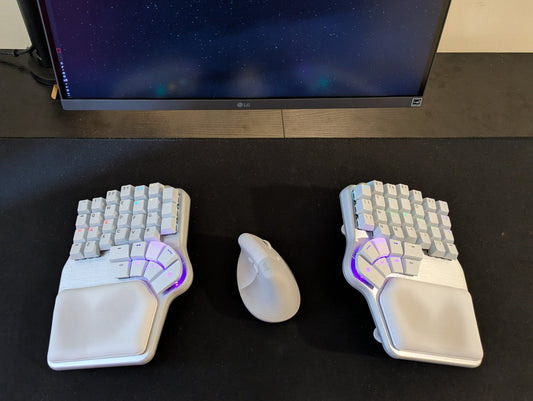Hey guys!
We are trying as much as possible to compile all the updates we have during the week. This will allow us to give you a more thorough and complete update. So we apologise if this update has taken a bit longer than expected.
Trip to Shenzhen Part II – The Pearl River Delta
Manel Senís, our Product Manager, had a trip to Shenzhen this year. He visited numerous factories and agencies. His goal was to find the best partners and high-quality manufacturers for the Raise keyboard, and for Dygma’s future products.
Read more about his trip here.
Our tech solutions for the palm rest
The palm rest feature is important for all users. It gives support to both your hands when using the keyboard. It neutrally positions your hands thus reducing strain on your wrists when using the keyboard for long periods of time.
Here are the main features:
- Not fixed:
- The palm rest can be removed easily from the keyboard.
- It will have an anti-slip material.
- Cleanliness:
- The material of the palm rest can be easily cleaned.
- Materials:
- The base material is a neoprene foam.
- The top material is a fabric that wraps around the foam.
- Thickness:
- It will be between 3mm – 5mm.
- Eventually, we will be able to provide different thicknesses for individuals.
Prototyping Packaging Concepts
We are currently prototyping packaging concepts for the Raise keyboard.
As you might know by now, especially if you’ve been following our page, that we dedicate a lot of time and hard work in the development phase of all the Raise’s features. The packaging is an important aspect as this is our customer’s first experience with our product.
We are testing with users the different dimensions, materials, and designs.
One big characteristic we are excited with is the user-experience when opening the package of the Raise. What will they expect? Hmmm. ????
As always, we will keep you all updated with our developments.
The Body of the Raise keyboard
To talk about the body of the Raise keyboard, we ask our product manager Manel Senis some questions.
The finishing of the keyboard
The Raise’s body is made of anodized aluminum. After asking a few backers and gamers, we had the consensus of 2 colours: dark gray and silver. We also chose 2 different finishing: brushed and sand blasted. These create a different texture on the body.

How the structure is created
We finally decided to use a different industrial process to create this structure. The process is called stamping. This process uses a mold and presses the aluminum sheet metal to create the shape we want. This shape will also be anodized.

The round edges were a challenge for us but we have worked with the manufacturers to get the most aesthetic angles best for the keyboard.
As for the round radius, at the back of the keyboard there is a 4.5 millimetre radius, and the front has a 1.5 millimetre radius. We did this because the keyboard has a 3 degree tilting, which after many prototypes, we concluded is the ideal amount.

The process of creating this design is challenging because we are going to the limit of the technology to get the shape we like. But we believe that the round edges are important in a functional point of view because we don’t want to have sharp edges. At the same time, in an aesthetic point of view, it looks better.
How the body of the Raise is assembled
The Raise is assembled in an automated factory. Initially, the screws were found at the top of the keyboard but we decided to change this. Now, all the screws that are used to assemble the keyboard are found at the bottom, using threaded inserts.

How the electronic components are connected
We have our main PCB and another PCB for the low profile switches. We connect the PCBs using the inserts. The PCB and the switches are independent from each other. For this reason, you can change your switches.
The switch hole also needs to have the exact dimensions as we take into consideration the easy removal and fitting of the switches.
We also need to customise the thickness of the holes. For the regular switches, the thickness of the holes is 1.5 millimetres, and for the low profile switches, it’s 1.25 millimetres.

How we measure the Raise’s latency and jitter
In this tech video, Matt explains how we are measuring the Raise’s latency and jitter and why this is important for gamers.









